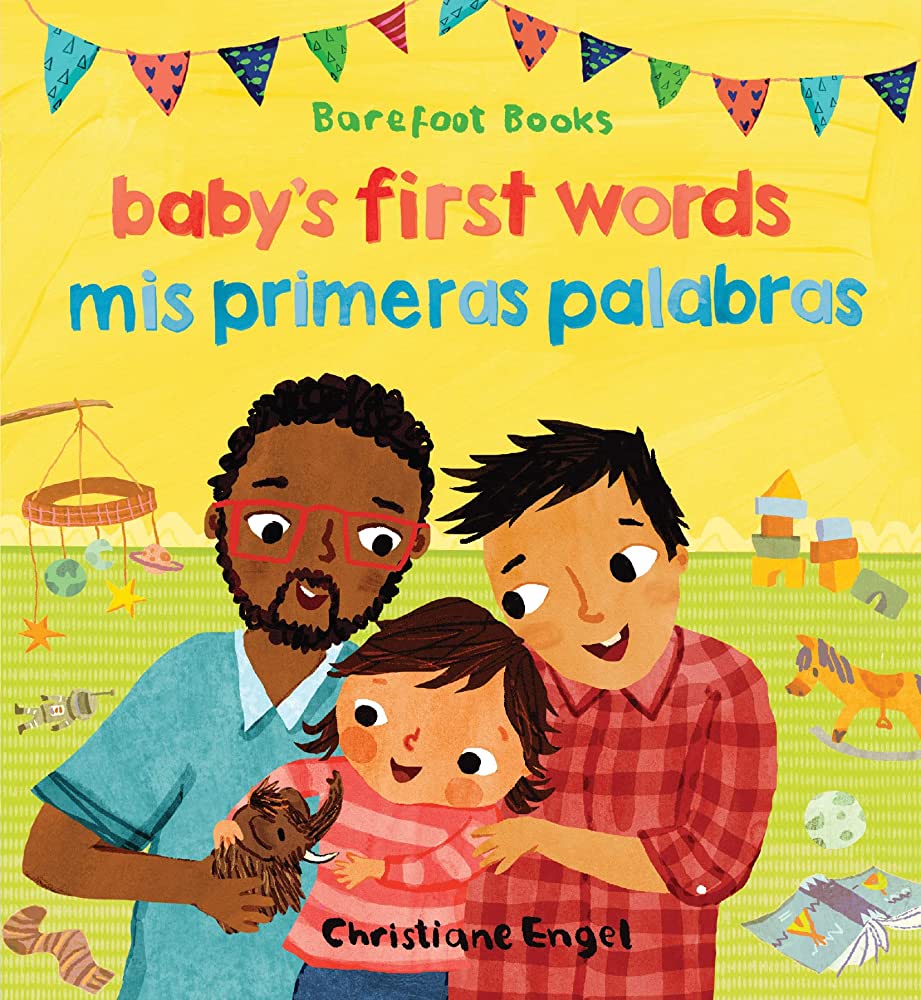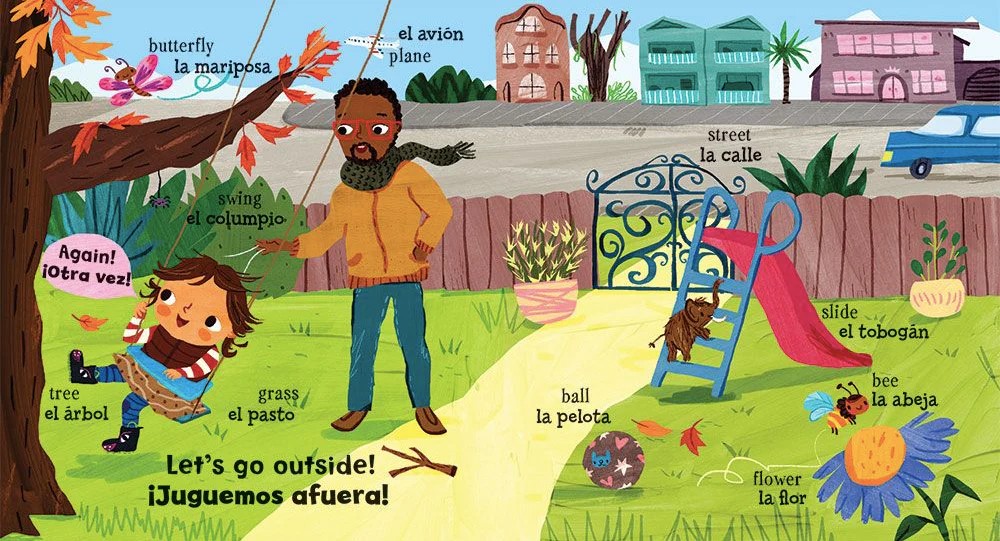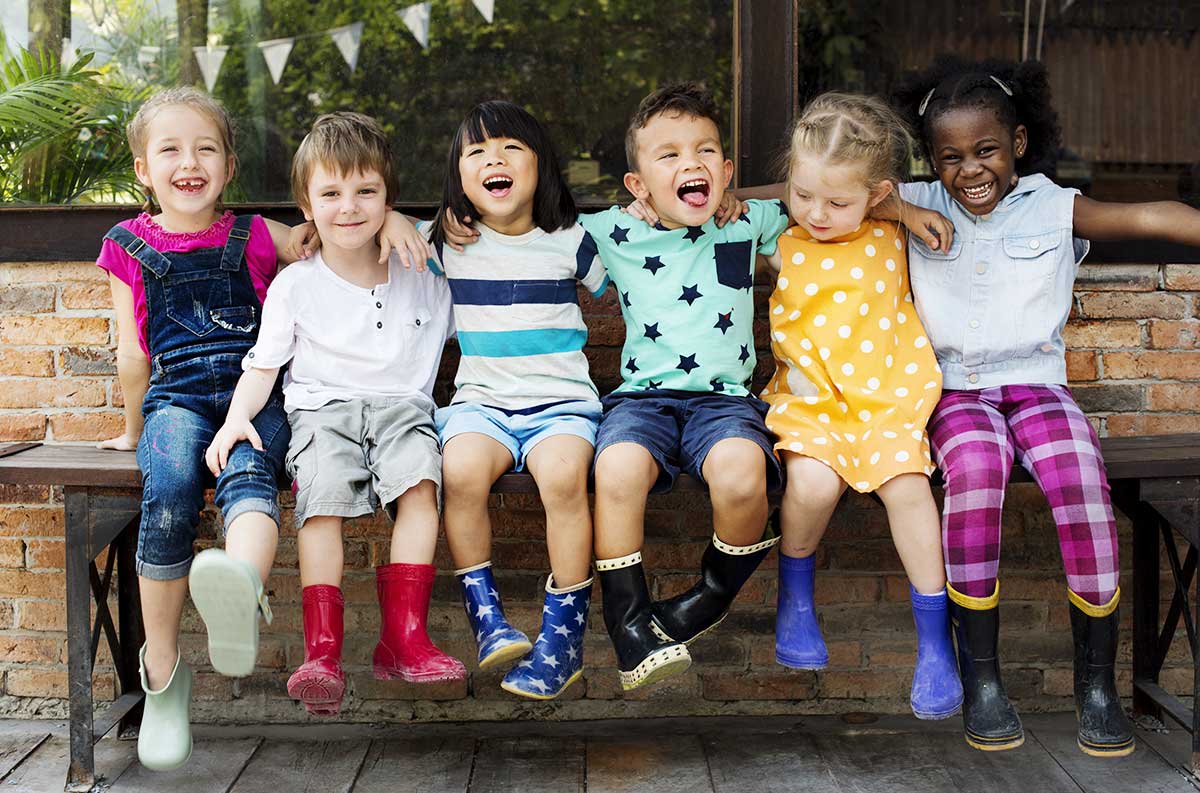
Inclusive Children's Book Teaching Guide
Baby’s First Words/Mis Primeras Palabras
What is this book about?
Learn over 100 early vocabulary words with a toothy toddler and her two dads. Cheerful illustrations and digital collage artwork will keep little eyes glued to the book as the children search for the silly woolly mammoth on each page.
Designed to support babies' natural patterns of language development, this first-word book for the modern world reflects the earliest nouns, verbs, prepositions, adjectives, and interjections that children learn to say.
Baby’s First Words/Mis Primeras Palabras is also available in bilingual Spanish-English and Spanish-only editions.
Who is depicted in this book?
- An LGBTQ+ led, multiracial family
What early childhood themes and concepts does this book explore?
- A different category—such as clothes, transportation or bathtime—is depicted on each of the book's spreads.
- Common English and Spanish vocabulary words and phrases that a young child can understand (e.g., teddy bear, street, qué es esto?)
- Early words and facial expressions that express different emotions such as happy, sad or angry
- Daily routines in a family
- Matching pictures or searching for familiar objects presented in a new or unfamiliar context
How does this book support anti-bias education?
Through the range of activities with the baby’s two dads, this book features family pride, along with positive depictions of LGBTQ+ identities.
Depending on how the book is shared or used—and the developmental level of the children—Baby’s First Words/Mis Primeras Palabras may be used to support the following core goal from Anti-Bias Education for Young Children and Ourselves:
Identity—Teachers will nurture each child’s construction of knowledgeable and confident personal and social identities so that children will demonstrate self-awareness, confidence, family pride, and positive social identities.
How can this book be used to meet early childhood learning standards?
For all ages
Use Baby’s First Words/Mis Primeras Palabras to meet early childhood literacy standards >
For children from birth to age three
Teaching suggestion: Point out examples of play, other everyday actions and the familiar settings in this book. Even the youngest children can react to, point at, or name them!
What Illinois Early Learning Guideline does this meet for children from birth to age three?
Developmental DomainSocial-Emotional Development
Standard: Relationship with PeersChildren demonstrate the desire and develop the ability to engage and interact with other children.
Indicators for children:
- Begins to engage in parallel play, in closer proximity to other children but without attempted interaction (7–18 months)
- Begins to engage in simple reciprocal interactions, such as rolling a ball back and forth (16–24 months)
- Demonstrates a preference for select peers (21–36 months)
Teaching suggestion: Model the actions and sounds of the people, animals and vehicles as they are depicted in the illustrations. Encourage back-and-forth imitation!
What Illinois Early Learning Guideline does this meet for children from birth to age three?
Developmental DomainLanguage Development, Communication and Literacy
Standard: Early LiteracyChildren demonstrate interest in and comprehension of printed materials.
Indicators for children:
- Imitates gestures and sounds during activities (7–18 months)
- Repeats familiar words in a book while being read to (16–24 months)
Teaching suggestion: Point to and name family members, using names that children will recognize.
What Illinois Early Learning Guideline does this meet for children from birth to age three?
Developmental DomainLanguage Development, Communication and Literacy
Standard: Expressive CommunicationChildren demonstrate the ability to understand and convey thoughts through both nonverbal and verbal expression.
Indicators for children:
- Utters first words for familiar objects and people (7–18 months)
Teaching suggestion: If you're using the board book edition, encourage the children to turn the tabbed pages.
What Illinois Early Learning Guideline does this meet for children from birth to age three?
Developmental DomainLanguage Development, Communication and Literacy
Standard: Early LiteracyChildren demonstrate interest in and comprehension of printed materials.
Indicators for children:
- Reaches out to grasp and mouth books (Birth–9 months)
- Uses hands to manipulate printed materials, such as attempting to turn the pages of a board book (Birth–9 months)
- Initiates literacy activities (7–18 months)
- Turns the pages of a board book one by one (16–24 months)
Teaching suggestion: For the board book edition, encourage the children to find the people, animals and objects in the various categories depicted on each tab in the book.
What Illinois Early Learning Guideline does this meet for children from birth to age three?
Developmental DomainCognitive Development
Standard: Concept DevelopmentChildren demonstrate the ability to connect pieces of information in understanding objects, ideas and relationships.
Indicators for children:
- Begins to identify characteristics of objects, such as “a red ball” (16–24 months)
- Identifies characteristics of objects and people when named, such as colors (21–36 months)
- Identifies categories, such as pointing out all of the animals in a picture, even when different types of objects are represented
Teaching suggestion: Identify and ask questions about different aspects of the daily routines depicted in the illustrations. Which ones are familiar to the children in your classroom?
What Illinois Early Learning Guideline does this meet for children from birth to age three?
Developmental DomainLanguage Development, Communication and Literacy
Standard: Early LiteracyChildren demonstrate interest in and comprehension of printed materials.
Indicators for children:
- Begins to engage in parallel play, in closer proximity to other children, without attempting interaction (7–18 months)
- Begins to engage in simple reciprocal interactions such as rolling a ball back and forth (16–24 months)
- Demonstrates a preference for select peers (21–36 months)
For preschoolers (ages three to five)
Teaching suggestion: Discuss clues in the book about how the child appears to be feeling and why.
What Illinois Early Learning and Development Standards does this meet for preschoolers?
Social/Emotional Development Standard31ADevelop positive relationships with peers and adults.
Benchmark 31.A.ECb:
Recognize the feelings and perspectives of others.
Teaching suggestion: Encourage the children to describe what they see happening as the family goes about its daily routines, including the categories and types of activities that are depicted.
What Illinois Early Learning and Development Standards does this meet for preschoolers?
Language Arts Standard1EUse increasingly complex phrases, sentences and vocabulary.
Benchmark 1.E.ECa:
With teacher assistance, begin to use increasingly complex sentences.
Benchmark 1.E.ECb:
Exhibit curiosity and interest in learning new words heard in conversations and books.
Benchmark 1.E.ECd:
With teacher assistance, explore word relationships to understand the concepts represented by common categories of words (e.g., food, clothing, vehicles).
Teaching suggestion: For children who speak Spanish at home, this book provides an opportunity to bridge home-language literacy skills and English. Ask the children to share the Spanish words for objects and ideas in the book and pair with them the corresponding English words to support emergent biliteracy.
What Illinois Early Learning and Development Standards does this meet for preschoolers?
English Language Learner Home Language Development Standard29AUse the home language to attain benchmarks across all the learning areas and to build upon and develop transferable language and literacy skills.
Benchmark 29.A.ECc:
Exhibit foundational literacy skills in home language to foster transfer to English.
See inside this book.

